


GEORGE STUBBS 1724 -
xxxxxThe English artist George Stubbs is well known for his brilliant paintings of horses. By means of dissection and painstaking drawings he produced his The Anatomy of the Horse in 1766. He settled in London in 1760, and was soon in demand by the aristocracy of the sporting fraternity, producing hunting, shooting and racing scenes, as well as portraits of the outstanding race horses of the day. Among his many works were The Grosvenor Hunt, Grimcrack on Newmarket Heath, and Mares and Foals in a Landscape. He also produced scenes of country activities, such as his Harvesters and Reapers, and, by contrast, painted a large variety of exotic animals -
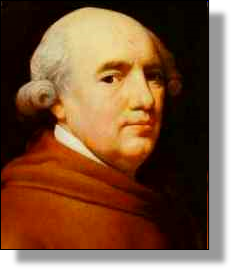 xxxxxxThe English artist George Stubbs is well known, above all, for his paintings of horses. Possessed of a remarkable knowledge of the anatomy of the horse, he was much in demand as an animal painter, producing numerous paintings of famous hunters and race horses. But he was also an accomplished painter of rural scenes, family groups, and “conversation pieces,” and this width of talent affords him a place amongst the foremost English artists of the 18th century.
xxxxxxThe English artist George Stubbs is well known, above all, for his paintings of horses. Possessed of a remarkable knowledge of the anatomy of the horse, he was much in demand as an animal painter, producing numerous paintings of famous hunters and race horses. But he was also an accomplished painter of rural scenes, family groups, and “conversation pieces,” and this width of talent affords him a place amongst the foremost English artists of the 18th century.
xxxxxxStubbs was born in Liverpool, the son of a successful tanner (currier). He worked for his father until his mid-
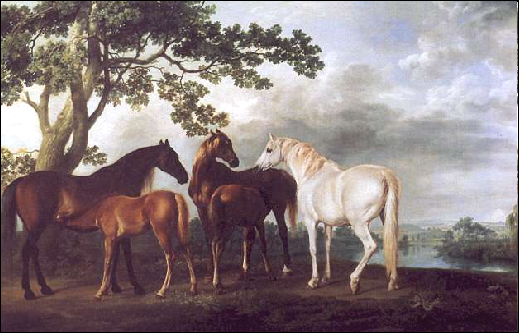 xxxxxxIn 1754 he went to Rome but did not stay long. On his return, anxious to avoid further hostility concerning his morbid interest, he rented a farmhouse in Horkstow, a remote Lincolnshire village. It was here that, over 18 months or so, he carried out a series of dissections on horses. Conducted with painstaking precision and acute observation, he then made careful notes and detailed drawings of his findings. He settled in London in 1760 and, finding no one to engrave his drawings, produced them himself. These 18 plates of anatomical drawings -
xxxxxxIn 1754 he went to Rome but did not stay long. On his return, anxious to avoid further hostility concerning his morbid interest, he rented a farmhouse in Horkstow, a remote Lincolnshire village. It was here that, over 18 months or so, he carried out a series of dissections on horses. Conducted with painstaking precision and acute observation, he then made careful notes and detailed drawings of his findings. He settled in London in 1760 and, finding no one to engrave his drawings, produced them himself. These 18 plates of anatomical drawings -
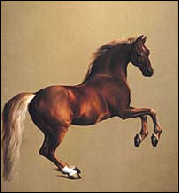 xxxxxxIn addition to such general sporting events, he produced some magnificent portraits of the outstanding race horses of the day, such as Gimcrack on Newmarket Heath and the prancing Whistlejacket (illustrated), originally intended to have a portrait of George III on his back! And some of his finest work is to be seen in his informal groups, such as Mares and Foals by a Stream (illustrated above), and Mares and Foals in a Landscape, now in the Tate Gallery, London. He also painted some delightful scenes of familiar country activities, such as the Haymakers and Reapers. Somewhat formal in composition, they were both painted in 1785, and are also in the Tate Gallery. He was also a fine portraitist, as seen by his self-
xxxxxxIn addition to such general sporting events, he produced some magnificent portraits of the outstanding race horses of the day, such as Gimcrack on Newmarket Heath and the prancing Whistlejacket (illustrated), originally intended to have a portrait of George III on his back! And some of his finest work is to be seen in his informal groups, such as Mares and Foals by a Stream (illustrated above), and Mares and Foals in a Landscape, now in the Tate Gallery, London. He also painted some delightful scenes of familiar country activities, such as the Haymakers and Reapers. Somewhat formal in composition, they were both painted in 1785, and are also in the Tate Gallery. He was also a fine portraitist, as seen by his self-
Acknowledgements
Stubbs; Self-
G3a-
xxxxxxIn general Stubbs’ works are characterised by an atmosphere of elegance, charm and calm, but -
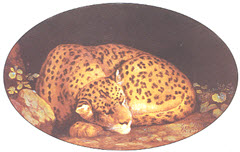
xxxxxxYet despite a good clientele, during his last twenty years Stubbs was frequently in debt, due in the main to his taking on ambitious schemes that brought in little money. For a number of years, for example, he worked closely with the master potter Josiah Wedgwood making enamel paintings on ceramic plaques. Attractive though they were -
xxxxxxA remarkable, resilient individual, Stubbs spent his life in search of new knowledge, and he is sometimes referred to as the greatest painter-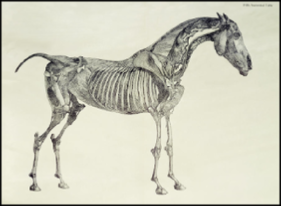 painting had an influence on, amongst others, the English artists Thomas Gainsborough and Sir Edwin Landseer.
painting had an influence on, amongst others, the English artists Thomas Gainsborough and Sir Edwin Landseer.
xxxxxxIncidentally, the pencil drawings for Stubbs’ remarkable series of engravings in his The Anatomy of the Horse are in the Royal Academy of Arts, London. ...... Four years after coming to London he moved to a house in Somerset Street, a site now occupied by Selfridges department store.



